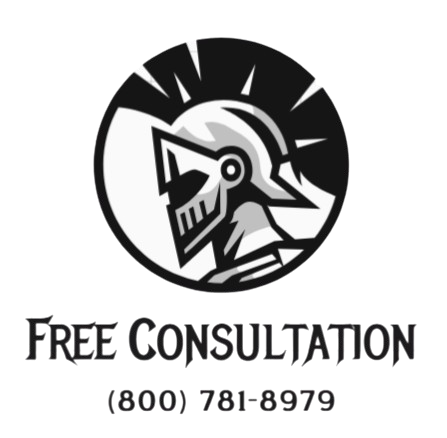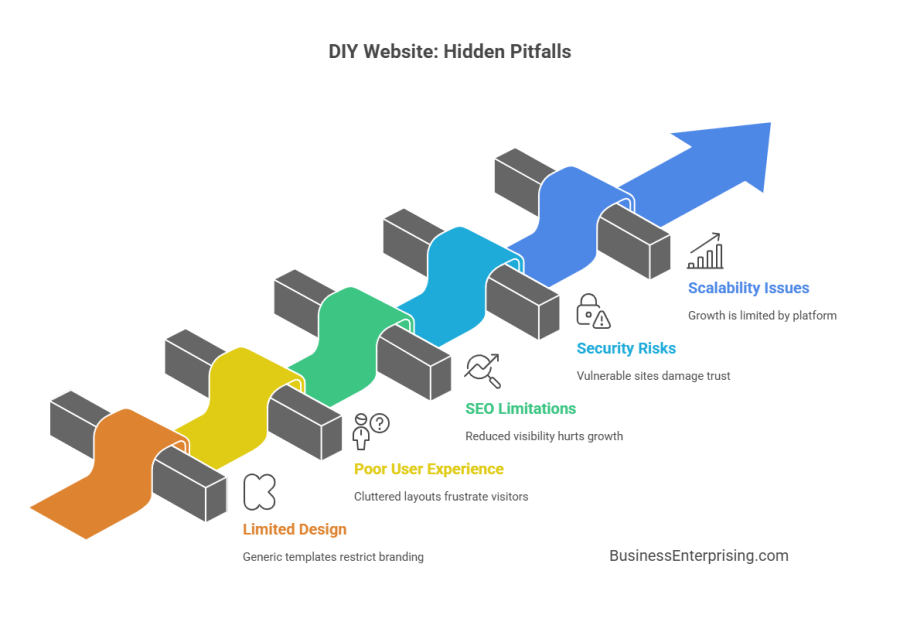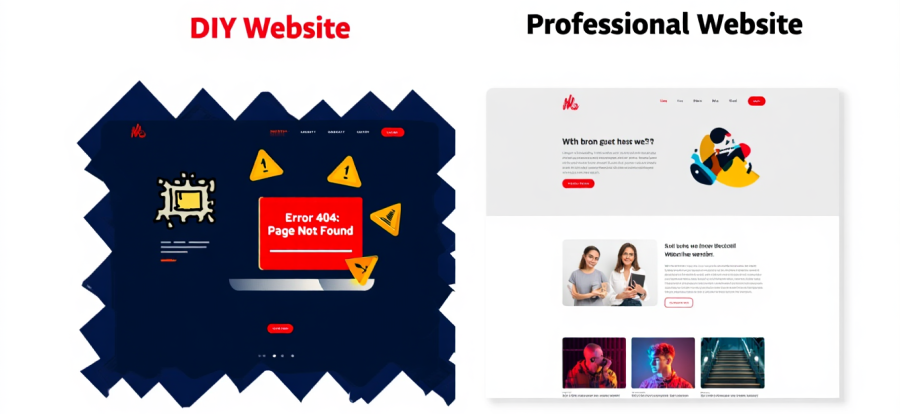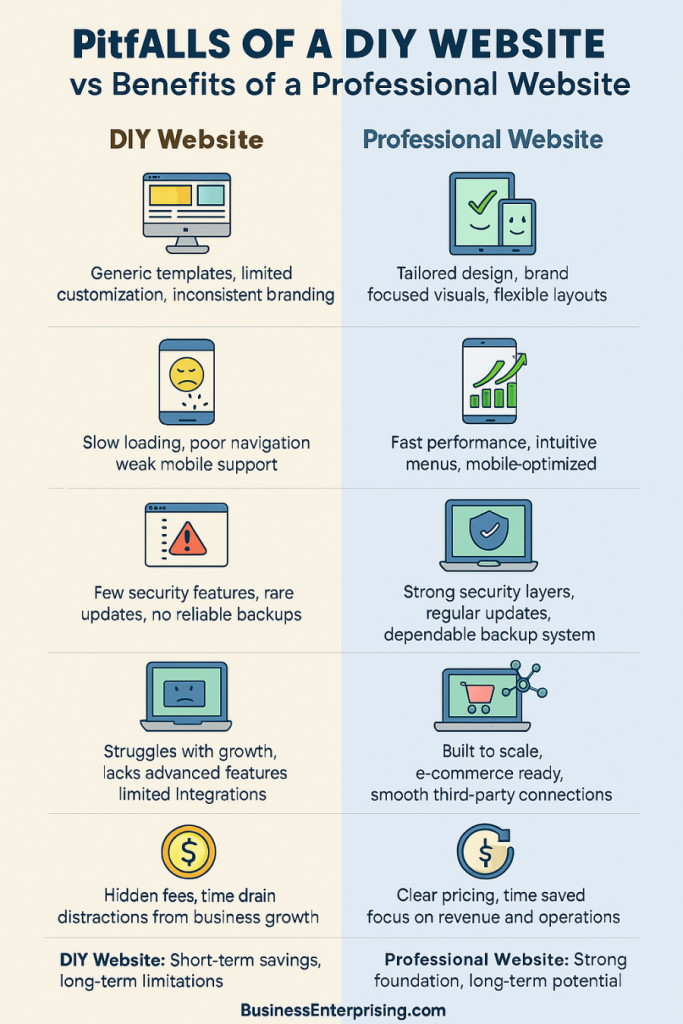
Additionally, online customers expect more than basic functionality. They want fast load times, mobile access, and simple navigation. If your site cannot deliver, you risk losing attention before your message is even seen. Therefore, what feels like savings at the beginning can easily lead to lost sales. A poorly built site may even damage credibility, making you appear less professional.
Design and performance are not the only concerns. Security, search optimization, and scalability all affect how well your site supports your business. DIY platforms often limit your ability to address these areas. Therefore, as your business grows, your website may hold you back instead of supporting progress. A weak foundation makes it harder to adapt or expand later.
Your website deserves the same level of planning you give other parts of your business. By understanding the risks, you can make better choices from the start. Therefore, investing in the right approach early saves time, money, and stress later on.
Limited Design and Branding Flexibility
When you build your website with a DIY tool, your options for design are often very limited. Templates are meant to be simple, but that simplicity usually comes at the expense of originality. Therefore, you end up with a site that looks like countless others. This lack of flexibility makes it difficult to build a brand that stands out.
Additionally, colors, fonts, and layouts may not fully match your brand identity. You may find that your vision is restricted by what the platform allows. Therefore, your website becomes a compromise rather than a clear reflection of your business. Customers notice these gaps and may feel less connected to your brand.
Your business deserves a design that reflects its values, not a cookie-cutter solution. However, DIY builders often lock you into limited customization. You may not be able to adjust features that matter, such as page structure or unique visual elements. Therefore, your online presence feels generic, reducing its ability to communicate your strengths.
Over time, this limitation affects growth. As your business evolves, your website should adapt with it. However, many DIY platforms lack advanced tools or design updates. You may face roadblocks when trying to scale or redesign. That means you invest more time fixing what should support you.
These limits highlight one of the common pitfalls of a DIY website. Your online presence is too important to leave in the hands of rigid templates. A custom-built site gives you the freedom to express your brand clearly and consistently.
Poor User Experience and Navigation
When visitors land on your site, they expect clarity and speed. DIY websites often fail to deliver either. Pages can load slowly, menus may be confusing, and layouts feel cluttered. Therefore, many visitors leave before exploring what you offer. A poor first impression can harm your ability to convert interest into sales.
Additionally, DIY platforms often limit mobile optimization. Most customers browse on phones, so a site that doesn’t adjust properly loses value. Buttons may be too small, text may not fit, and images may distort. Therefore, your site feels frustrating to use on the devices people rely on most.
Navigation is another issue. Customers expect intuitive menus that guide them to answers quickly. However, DIY sites often lack flexibility for organizing content. You may struggle to create a path that makes sense for your users. As a result, visitors leave when they cannot find what they want.
User experience directly connects to revenue. If your website feels clunky or confusing, customers will abandon it. Additionally, search engines may rank you lower if your site performs poorly. That means fewer people even find you in the first place.
These issues highlight one of the most common pitfalls of a DIY website. A confusing layout, slow load time, and poor mobile design can push away customers. Therefore, investing in a professional build helps you create a site that works with your business rather than against it.
SEO Limitations That Hurt Visibility
Search engines remain one of the main ways customers find businesses online. However, DIY website platforms often limit the tools you need for visibility. Many builders only allow basic keyword input, leaving out advanced features like structured data or technical optimization. Therefore, your site can struggle to compete with businesses that invest in more complete solutions.
Additionally, DIY platforms may restrict how you control page speed, meta descriptions, or site structure. These factors directly influence rankings. When you cannot adjust them, your site falls behind. Search engines reward sites that load quickly and provide clear information. Therefore, a DIY setup can hold you back even if your content is strong.
Mobile optimization also ties into search performance. If your DIY platform does not adapt properly, you risk lower rankings. Additionally, missing features like SSL certificates, sitemap control, and internal linking options reduce your ability to build authority. Over time, these gaps mean less traffic, fewer leads, and reduced visibility in your market.
You may spend hours adding content but still see little improvement in search performance. However, it isn’t your effort that’s the problem. It’s the limitations of the platform itself. These limits highlight one of the more damaging pitfalls of a DIY website.
To grow, you need the ability to fine-tune technical settings and content alike. Without those options, your reach stays limited. Therefore, investing in professional support can give you access to the tools that actually make search engines notice you.
Security Risks and Maintenance Challenges
Security is one of the biggest concerns for any website, yet DIY platforms rarely provide enough protection. Many do not offer strong firewalls, malware monitoring, or regular patching. Therefore, your site may be left open to hackers looking for easy targets. A single breach can cost you lost revenue, damaged trust, and long recovery times.
Additionally, updates are often out of your control. DIY platforms handle them on their own schedules, not yours. That means you cannot react quickly to new threats. Therefore, your business may remain vulnerable longer than it should. Regular backups are also limited, leaving you at risk of losing data if something goes wrong.
Downtime is another issue. If your platform has server problems, you cannot fix them yourself. Customers who visit during outages see errors instead of your content. Therefore, you lose opportunities and credibility. Without reliable maintenance tools, even a short outage can affect sales and customer confidence.
You may also face challenges when scaling. As your business grows, more traffic and transactions demand stronger protections. However, DIY platforms often fail to keep up. This mismatch forces you into upgrades or migrations at the worst times. That creates stress and added expense.
These weaknesses reveal one of the common pitfalls of a DIY website. Security and maintenance should never be an afterthought. Your brand and your customers deserve a safe, reliable online presence. Therefore, investing in professional support is often the smarter choice to protect your time and reputation.
Scalability and Integration Issues
A website should grow with your business, but DIY platforms often struggle to keep up. As your needs expand, their limits become clear. Advanced features like custom databases, e-commerce upgrades, or specialized functions may not be available. Therefore, you may find yourself boxed in when you want to scale.
Additionally, many DIY sites lack seamless integration with outside tools. You may want to connect accounting systems, CRM software, or shipping platforms. However, the builder might not support those links. That creates manual work for you and increases the risk of errors. Over time, the lack of automation slows your growth and drains resources.
E-commerce expansion is another challenge. DIY platforms may only offer simple stores with limited product options or payment gateways. As your sales increase, you’ll want better inventory tracking, analytics, and customer management. Therefore, you may outgrow the platform before your business reaches its full potential. Moving everything later can be costly and disruptive.
Additionally, performance issues grow as traffic increases. Many DIY builders cannot handle high volumes of visitors or complex functionality. That leads to slower load times and potential crashes. These problems directly impact sales and customer trust.
These challenges highlight one of the overlooked pitfalls of a DIY website. What seems fine at the start often fails under pressure. Therefore, planning for scalability early is smarter than patching problems later. A professional build gives you the flexibility to grow without starting over each time your business expands.
Hidden Costs and Time Drain
Many DIY website builders market themselves as free or inexpensive, but the reality is different once you start using them. Basic features may be included, yet many important tools are hidden behind extra fees. Therefore, you often need to pay for add-ons such as security upgrades, e-commerce functions, or advanced design options. What begins as a low-cost solution can quickly grow into a significant expense.
Additionally, your time becomes a hidden cost. Building and managing a site takes more effort than you expect. You’ll spend hours adjusting layouts, fixing errors, and updating content. Therefore, time you could invest in growing your business gets tied up in maintenance. The learning curve adds even more frustration, especially when the platform doesn’t perform as promised.
Over time, these small costs and wasted hours add up. The money you save upfront disappears in recurring charges. The hours you dedicate to tinkering with the site prevent you from focusing on revenue-generating activities. Therefore, the supposed savings may harm your long-term growth.
These challenges show why the hidden costs and time drain are common pitfalls of a DIY website. What seems affordable at the start can actually hold back your business. Therefore, a professional approach often provides better value because it frees your time and reduces ongoing costs. When you focus on running your company instead of running a website, you create more space for success.
Conclusion
Building your own website may seem like a simple way to save money, but the long-term tradeoffs are often bigger than expected. Templates, limited tools, and hidden costs can all reduce the value of your online presence. Therefore, you need to weigh short-term convenience against long-term growth. A weak website can quietly hold back your business while you focus on other areas.
Additionally, user experience and search visibility play a large role in customer trust. A site that loads slowly or ranks poorly can reduce your chances of gaining new clients. Security gaps and limited support add even more risk. Therefore, what feels like control often turns into extra work, higher costs, and missed opportunities.
Over time, these challenges highlight the many pitfalls of a DIY website. While it might help you get online quickly, it rarely provides the flexibility or support your business needs. A professional build offers stronger performance, better tools, and the ability to scale with your goals. Therefore, investing wisely from the start allows you to focus on growth rather than fixing problems later.
Your website is often the first impression customers have of your company. Treat it as an asset, not a side project. By choosing the right foundation now, you create more space for your business to succeed in the future.



